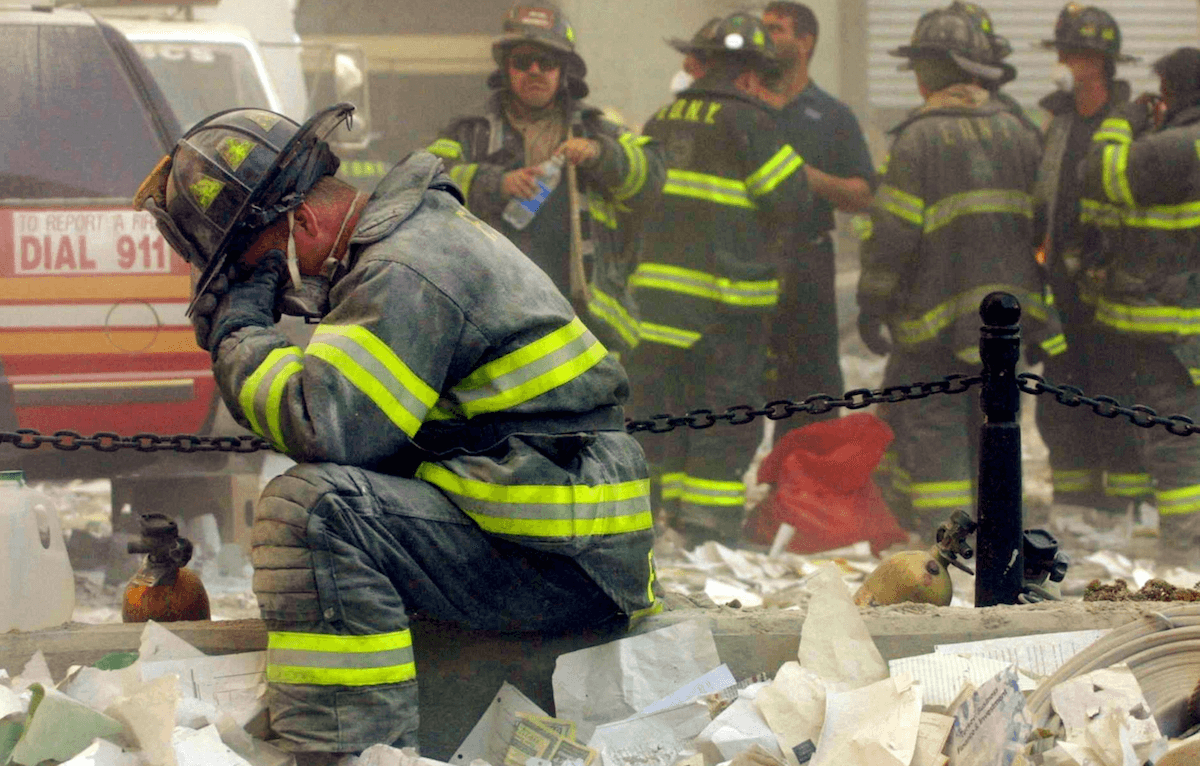Caring for the Other 9/11 Victims: Rescue Workers
Cancer and PTSD plague those who put their lives on the line at Ground Zero
It was 15 years ago this Sunday, that a beautiful, sunny fall morning became one of the darkest days in American history. On Sept. 11, 2001, we experienced the horror of nearly 3,000 tragic deaths in the deadliest terrorist attacks on U.S. soil. The horror coexisted, however, with the heroism of not just the first 9/11 responders, but bystanders racing to help others survive, including the unbelievable scene at what became known as Ground Zero in lower Manhattan.

Increased Cancer Risk for Boomer Rescuers
“The average age of the first responders in 2001 was 38. Today, they are 53 and at an age where they have a higher risk for diseases like cancer,” said Dr. Michael A. Crane, medical director of the World Trade Center clinic at Mount Sinai Hospital, one of seven Clinical Centers of Excellence treating World Trade Center (WTC) rescuers and survivors.
Since 2006, Crane has been treating those workers who spent time “on the pile” clearing debris and inhaling the toxic cocktail of chemicals and particles, including asbestos, benzene, fiberglass and mercury, created when the million-ton Twin Towers collapsed into a fiery, dusty heap.
Crane says that while the immediate health issues were upper respiratory, such as asthma, persistent coughing and sinusitis or gastrointestinal, such as acid reflux or gastroesophageal reflux disease (GERD), after 15 years he sees a “steady stream” of 9/11 survivors with cancer.
The delay is predictable; many cancers have a long latency period.
Higher Cancer Incidence Than Expected
Researchers associated with the World Trade Center Health Program issued a 2013 report that studied 21,000 rescue and recovery workers in the seven years after being at Ground Zero. They estimated a 15 percent higher incidence of cancer among the workers than in the general population. Other studies have shown increased incidence of thyroid, prostate and blood and lymph cancers in WTC first responders.
Crane estimated that he has seen 30 cases over the last couple of weeks. There are now more than 5,441 cancer patients in the program, a significant increase from the 1,822 cases reported between 2002 and 2014. That’s according to the World Trade Center Health Registry, a database with a diverse 71,000 enrollees of WTC first responders and rescuers as well as area businesspeople, tourists there on 9/11 and schoolchildren from lower Manhattan schools.
The WTC Registry has enrollees from every state and even those living internationally (people who visited the area that day), of which 10,000 are outside of metropolitan New York City. It is the largest post-disaster surveillance program effort in U.S. history.
The increased cancer risk is not a surprise to environmental health experts, cancer researchers and physicians. But researchers are still cautious about claiming direct connections between certain cancers and Ground Zero exposure.
Meanwhile, individual stories speak volumes.
Marcy Borders, a Bank of America employee who became famous as the “Dust Lady” from her emblematic 9/11 photo, died a year ago of stomach cancer at 42. Retired New York City police officer David Howley, who spent months at the WTC site after 9/11 and has been diagnosed with throat and neck cancer, gave riveting Congressional testimony to extend the funding for the James Zadroga 9/11 Health and Compensation Act last year. He stated emphatically: “If you end this program, people are going to die.”
The Mind-Body Connection
While 50 types of cancer have been identified by the federal government and added to the list of health issues as part of the WTC Health Program, first responders are also dealing with a mental and emotional toll.
Even for first responders trained in disaster relief, the impact was unimaginable.
Having bodies land at your feet after jumping from burning buildings or sifting through human remains to try to return them to grieving families is something you’d expect in a war zone, not the New York City streets. And having the pile shift and shake underneath their feet while the dust cloud continued to invade their eyes, nose and lungs, made the situation much worse.
“Being at Ground Zero in the days and weeks that followed 9/11 was not only a physical risk for the health of these rescuers, but it was a terrifying place to be,” Crane said. “The dust was chokingly thick — but also having to deal with the human remains debris had real impact on their emotional and psychological well-being. It was literally hell on earth.”
In fact, the WTC Health Registry reports that one in five enrollees has PTSD; the organization has issued several health impact studies related to PTSD. For instance, a study of 36,000 registry enrollees who reported PTSD at the time of enrollment (2003 to 2004), showed a 30 percent higher tendency to develop diabetes six to eight years later than those without PTSD.
Researchers felt this was because either the chronic stress of PSTD caused the body’s cells to become resistant to insulin, causing sugar buildup in the bloodstream, or enrollees adopted unhealthy behaviors in diet and physical inactivity often associated with PTSD.
“We see a connection between the mental, emotional impact of survivors and first responders — which includes PTSD and depression — and their physical health,” said Mark Farfel, director of the WTC Health Registry.
Farfel explained that social isolation, often a side effect of PTSD, can exacerbate other health issues of the WTC survivors and rescuers. Those registry enrollees with PTSD who have a family caregiver or other circles of support tend to fare better managing their other health issues.
You Before Me
“We didn’t want to take the place of someone else who really needed the care more,” is a comment Crane hears all the time from WTC first responders or their family members once they finally make their way into his program. Many are not aware that their health issues — whether upper respiratory, gastrointestinal problems or various cancers — are associated with their role in the 9/11 rescue effort.
One wife of a New York Police Department (NYPD) first responder (I’ll call her Carol since she asked to speak anonymously because of the stigma of PTSD) told me her husband started to withdraw from family life and social interaction after spending hours at Ground Zero. Carol said he would often just watch TV for hours without any conversation or interaction with others. He stopped going to their son’s baseball games and was distracted and agitated when talking to anyone.
Every year on Sept. 11, he would disappear for several hours only to return home late in the evening without a word about where he’d been. Though her husband had been only a social drinker, Carol could smell the alcohol on his breath when he came to bed.
One report from the WTC Health Registry stated that five to six years after the attacks, those with the greatest Ground Zero exposure who reported PTSD were twice as likely as the group with less or no exposure to binge drink four to five drinks at a time. Another study showed 50 percent of NYPD officers at Ground Zero who reported PTSD symptoms after the attacks were still suffering from the disorder in 2012 — more than a decade later.
“It got to a point where I did not want to contemplate divorce, but I was suffering too,” said Carol. “My husband did not die on Sept. 11, but I lost him all the same.”
Sharing the Burden
She finally found help through a friend whose son had returned home from Afghanistan with PTSD. This mother took Carol to a veterans’ caregiver support group meeting where PTSD was a regular topic. Hearing similar stories from other family caregivers shed light on a disorder Carol had not fully understood.
“These moms and wives had loved ones who saw the horrors of war — their wounds were invisible, but it was the same as losing an arm or leg — part of them was gone,” said Carol. “I finally understood the horror my husband experienced and that he was fighting his own war with invisible wounds I could not see.”
It took time, but Carol convinced her husband to go to counseling with her. Since then, he has started to step outside the shadows of the PTSD he suffered at Ground Zero.
For family caregivers, there is some relief in the recently reauthorized Zadroga Act, which ensures that the WTC survivor and rescue worker health care programs will continue for the lifetime of eligible victims — extended the next 75 years until 2090. Part of the funding goes to the September 11 Victim Compensation Fund, which will continue to be supported through 2020. Out of 13,437 claims to date, more than 9,100 victims and their families had received compensation as of the last 2015 report.
In addition, there is hope and healing through support groups and Sept. 11 remembrance activities.
“These World Trade Center patients and their families are the salt of the earth,” Crane said. “They are generous, altruistic, brave and heroic and it’s an honor for me to do this job.”
Watch the gripping 9/11 documentary filmed by two brothers who happened to be at an New York Fire Department firehouse on the morning of Sept. 11, broadcast with limited commercial interruption on CNN Sunday.

Sherri Snelling is a corporate gerontologist, speaker, and consultant in aging and caregiving. She is the author of “Me Time Monday – The Weekly Wellness Plan to Find Balance and Joy for a Busy Life” and host of the "Caregiving Club On Air" podcast. Read More

